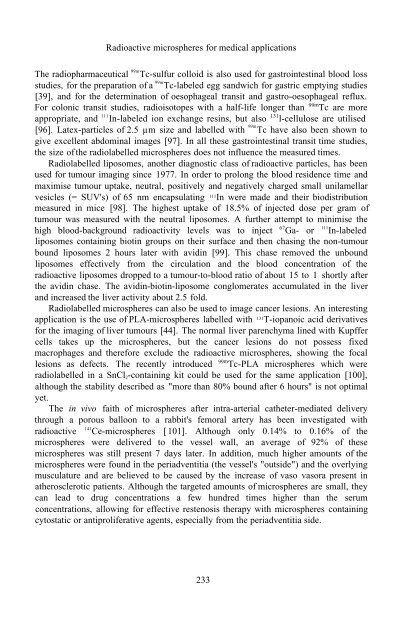Physics And Chemistry Basis Of Biotechnology - De Cuyper - tiera.ru
Physics And Chemistry Basis Of Biotechnology - De Cuyper - tiera.ru
Physics And Chemistry Basis Of Biotechnology - De Cuyper - tiera.ru
You also want an ePaper? Increase the reach of your titles
YUMPU automatically turns print PDFs into web optimized ePapers that Google loves.
Radioactive microspheres for medical applications<br />
The radiopharmaceutical 99m Tc-sulfur colloid is also used for gastrointestinal blood loss<br />
studies, for the preparation of a 99m Tc-labeled egg sandwich for gastric emptying studies<br />
[39], and for the determination of oesophageal transit and gastro-oesophageal reflux.<br />
For colonic transit studies, radioisotopes with a half-life longer than 99mTc are more<br />
appropriate, and 111 In-labeled ion exchange resins, but also 131l-cellulose are utilised<br />
[96]. Latex-particles of 2.5 µm size and labelled with 99m<br />
Tc have also been shown to<br />
give excellent abdominal images [97]. In all these gastrointestinal transit time studies,<br />
the size of the radiolabelled microspheres does not influence the measured times.<br />
Radiolabelled liposomes, another diagnostic class of radioactive particles, has been<br />
used for tumour imaging since 1977. In order to prolong the blood residence time and<br />
maximise tumour uptake, neutral, positively and negatively charged small unilamellar<br />
vesicles (= SUV's) of 65 nm encapsulating 111In were made and their biodistribution<br />
measured in mice [98]. The highest uptake of 18.5% of injected dose per gram of<br />
tumour was measured with the neutral liposomes. A further attempt to minimise the<br />
67 111<br />
high blood-background radioactivity levels was to inject Ga- or In-labeled<br />
liposomes containing biotin groups on their surface and then chasing the non-tumour<br />
bound liposomes 2 hours later with avidin [99]. This chase removed the unbound<br />
liposomes effectively from the circulation and the blood concentration of the<br />
radioactive liposomes dropped to a tumour-to-blood ratio of about 15 to 1 shortly after<br />
the avidin chase. The avidin-biotin-liposome conglomerates accumulated in the liver<br />
and increased the liver activity about 2.5 fold.<br />
Radiolabelled microspheres can also be used to image cancer lesions. An interesting<br />
application is the use of PLA-microspheres labelled with 131T-iopanoic acid derivatives<br />
for the imaging of liver tumours [44]. The normal liver parenchyma lined with Kupffer<br />
cells takes up the microspheres, but the cancer lesions do not possess fixed<br />
macrophages and therefore exclude the radioactive microspheres, showing the focal<br />
lesions as defects. The recently introduced 99mTc-PLA microspheres which were<br />
radiolabelled in a SnCl2-containing kit could be used for the same application [100],<br />
although the stability described as "more than 80% bound after 6 hours" is not optimal<br />
yet.<br />
The in vivo faith of microspheres after intra-arterial catheter-mediated delivery<br />
through a porous balloon to a rabbit's femoral artery has been investigated with<br />
radioactive 141 Ce-microspheres [ 101]. Although only 0.14% to 0.16% of the<br />
microspheres were delivered to the vessel wall, an average of 92% of these<br />
microspheres was still present 7 days later. In addition, much higher amounts of the<br />
microspheres were found in the periadventitia (the vessel's "outside") and the overlying<br />
musculature and are believed to be caused by the increase of vaso vasora present in<br />
atherosclerotic patients. Although the targeted amounts of microspheres are small, they<br />
can lead to d<strong>ru</strong>g concentrations a few hundred times higher than the se<strong>ru</strong>m<br />
concentrations, allowing for effective restenosis therapy with microspheres containing<br />
cytostatic or antiproliferative agents, especially from the periadventitia side.<br />
233












